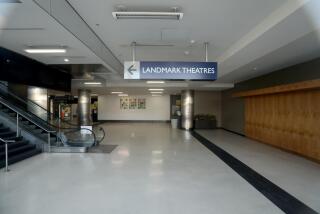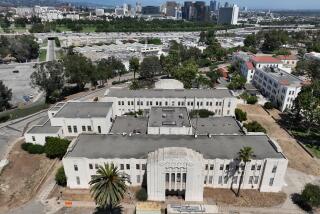Oxnard Unveils Plans for College Park
- Share via
Dog owners would get two parks, and a women’s recovery center would get the boot under a $15-million proposed makeover unveiled this week for College Park in Oxnard.
During a four-hour meeting, city officials discussed relocating the Rainbow Recovery Center and several possible funding sources for the park project.
Controversy is still swirling over what to do about the recovery center, which has been at the park for 17 years.
When the county transferred ownership of the park to the city in 2000, the deed stated that the 75-acre property could only be used for “parks and recreation purposes,” officials said.
City Manager Ed Sotelo and several council members on Tuesday suggested finding another site for the center. But Mayor Manuel Lopez asked city staff to meet with county officials to see if the deed restrictions are flexible enough that the recovery center can be kept at College Park.
“I believe the city has a big enough heart to accommodate the Rainbow House and the museum,” Lopez said.
A Rainbow representative said the community supports keeping the recovery center where it is. She said the center has received many favorable letters from residents in the past two weeks.
“South Oxnard wants us to stay here,” said Kathleen McQuillan, executive director of the Rainbow Recovery Center. “It’s their neighborhood, so they should have a say in it.” McQuillan suggested that the center was not included in the city’s plan because it does not have the political clout of the Ventura County Museum of History and Art, which under the city’s plan would occupy the two old farmhouses now used by the recovery center.
“The museum has a lot of wealthy, powerful people on their board,” McQuillan said. “We’re a local, bare nonprofit organization struggling to keep our doors open.”
The city’s improvement plan calls for development of a nine-acre dog park and a three-acre park, baseball and soccer fields, a lighted basketball area, a fenced skate park and a 26,000-square-foot community center with a gym.
The park would also include picnic areas, playgrounds, jogging and bicycle trails and a farm heritage area.
One of the farmhouses used by the recovery center would be converted into a farm museum dedicated to the county’s agricultural history. It’s not clear, however, how the other farmhouse would be used.
City officials stressed that the plan is just a draft, and that they are still exploring ways to pay for the park improvements. “All we have now are drawings,” City Atty. Gary Gillig said. “We still have to pay for all of this.”
The City Council’s staff on Tuesday recommended the formation of an assessment district to pay for the improvements. Under the plan, homeowners would be assessed about $28 a year, which would raise about $1.2 million annually.
The new park could be developed over 12 years, or sooner if bonds are sold as part of the financing package, said financial services manager Mike More. One other financing option would be for the city to tap into a $2.6-billion state bond measure approved earlier this year.
Dog owners in search of a place to exercise their pets were among dozens of residents who spoke out about the park plan at the council meeting. They had requested one dog area but received two.
“The city has made an honest effort,” said resident Chuck Wright, pointing out that there are 15,000 dogs in Oxnard. “You can’t please everyone. But the dog park people are happy because we have nothing [now].”
Meanwhile, the council directed its staff to come back with more detailed plans for the farm heritage museum area. In addition to a museum, the area would include a caretaker’s house, a blacksmith’s shop and a barn, gardens, crop displays and shops.
Oxnard officials expect to hold another study session on the proposed College Park master plan this fall.
More to Read
Sign up for Essential California
The most important California stories and recommendations in your inbox every morning.
You may occasionally receive promotional content from the Los Angeles Times.










